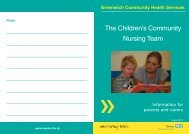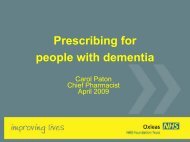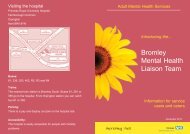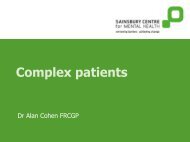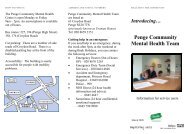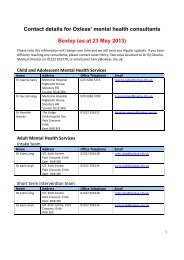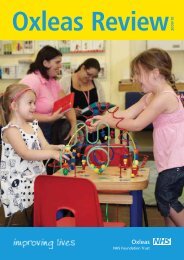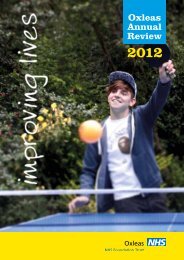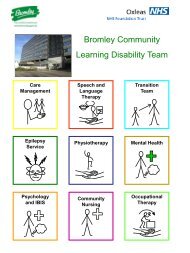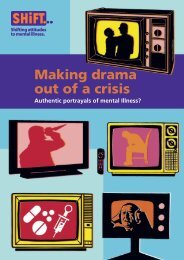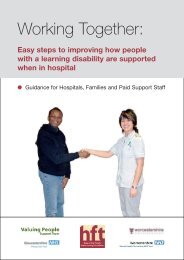Dignity in health care for people with learning disabilities
Dignity in health care for people with learning disabilities
Dignity in health care for people with learning disabilities
You also want an ePaper? Increase the reach of your titles
YUMPU automatically turns print PDFs into web optimized ePapers that Google loves.
<strong>Dignity</strong> <strong>in</strong> <strong>health</strong> <strong>care</strong> <strong>for</strong> <strong>people</strong><strong>with</strong> learn<strong>in</strong>g <strong>disabilities</strong>RCN guidance
ContributorsThis booklet was written by Steve Hardy, Tra<strong>in</strong><strong>in</strong>g and Consultancy Manager, EstiaCentre, South London and Maudsley NHS Foundation Trust, <strong>with</strong> support from membersof the RCN Learn<strong>in</strong>g Disability Nurs<strong>in</strong>g Forum.RCN Learn<strong>in</strong>g Disability Nurs<strong>in</strong>g ForumJim Blair, Consultant Nurse (Learn<strong>in</strong>g Disabilities),St. George’s Health<strong>care</strong> NHS TrustDr Michael Brown, Nurse Consultant, NHS LothianPrimary Care Organisation and Lecturer, School ofCommunity Health, Napier UniversityMandy Dun<strong>for</strong>d, Community Nurse Learn<strong>in</strong>gDisabilities, Hounslow Primary Care TrustMichael Gregory, Community Behavioural Nurse,Northern Area Health and Social Services TrustAnn Norman, Professional Nurse Adviser <strong>for</strong>Learn<strong>in</strong>g Disability and Prison Nurses, Royal Collegeof Nurs<strong>in</strong>gRuth Northway, Professor of Learn<strong>in</strong>g DisabilityNurs<strong>in</strong>g, University of GlamorganMichelle Persaud, Associate Director of Nurs<strong>in</strong>g,Nott<strong>in</strong>ghamshire Health Care NHS Trust, and Chair ofthe RCN Learn<strong>in</strong>g Disability ForumSteer<strong>in</strong>g GroupSue Carmichael, Valu<strong>in</strong>g People Now Lead on Healthand People <strong>with</strong> Complex Needs, Department ofHealthJanet Cobb, Associate Consultant, Foundation <strong>for</strong>People <strong>with</strong> Learn<strong>in</strong>g DisabilitiesJo Dwyer, Cl<strong>in</strong>ical Specialist Occupational Therapist(mental <strong>health</strong> <strong>in</strong> learn<strong>in</strong>g <strong>disabilities</strong>), SouthwarkPrimary Care NHS TrustSarah Halls, Tra<strong>in</strong><strong>in</strong>g Officer, Estia Centre, SouthLondon and Maudsley NHS Foundation TrustDr Gerald<strong>in</strong>e Holt, Honorary Senior Lecturer, SouthLondon and Maudsley NHS Foundation Trust, EstiaCentre, K<strong>in</strong>gs College London, and the Institute ofPsychiatry, LondonFiona H<strong>in</strong>d, Physical Health<strong>care</strong> Facilitator,Nott<strong>in</strong>ghamshire Health<strong>care</strong> TrustJennifer Luchoomun, Nurs<strong>in</strong>g Student, FlorenceNight<strong>in</strong>gale School of Nurs<strong>in</strong>g and Midwifery, K<strong>in</strong>g’sCollege London, and Member, Association of Nurs<strong>in</strong>gStudents Executive Committee, London RegionDebra Moore, Manag<strong>in</strong>g Director, Debra MooreAssociatesElizabeth Tysoe, Head of Health Inspection, HMInspectorate of PrisonsExpert PanelPeter Cron<strong>in</strong>Peter Devl<strong>in</strong>Lana DunnetAnne OnwuegbuzieLiam PeytonBarry StennetBeccy SullivanJane WallaceYolanda ZimockRCN Legal DisclaimerThis publication conta<strong>in</strong>s <strong>in</strong><strong>for</strong>mation, advice and guidance to help members of the RCN. It is <strong>in</strong>tended <strong>for</strong> use <strong>with</strong><strong>in</strong> the UK but readers are advised thatpractices may vary <strong>in</strong> each country and outside the UK.The <strong>in</strong><strong>for</strong>mation <strong>in</strong> this publication has been compiled from professional sources, but its accuracy is not guaranteed. Whilst every ef<strong>for</strong>t has been made toensure the RCN provides accurate and expert <strong>in</strong><strong>for</strong>mation and guidance, it is impossible to predict all the circumstances <strong>in</strong> which it may be used.Accord<strong>in</strong>gly, to the extent permitted by law, the RCN shall not be liable to any person or entity <strong>with</strong> respect to any loss or damage caused or alleged to becaused directly or <strong>in</strong>directly by what is conta<strong>in</strong>ed <strong>in</strong> or left out of this <strong>in</strong><strong>for</strong>mation and guidance.Published by the Royal College of Nurs<strong>in</strong>g, 20 Cavendish Square, London, W1G 0RN© 2009 Royal College of Nurs<strong>in</strong>g. All rights reserved. Other than as permitted by law no part of this publication may be reproduced, stored <strong>in</strong> a retrievalsystem, or transmitted <strong>in</strong> any <strong>for</strong>m or by any means electronic, mechanical, photocopy<strong>in</strong>g, record<strong>in</strong>g or otherwise, <strong>with</strong>out prior permission of thePublishers or a licence permitt<strong>in</strong>g restricted copy<strong>in</strong>g issued by the Copyright Licens<strong>in</strong>g Agency, Saffron House, 6-10 Kirby Street, London EC1N 8TS. Thispublication may not be lent, resold, hired out or otherwise disposed of by ways of trade <strong>in</strong> any <strong>for</strong>m of b<strong>in</strong>d<strong>in</strong>g or cover other than that <strong>in</strong> which it ispublished, <strong>with</strong>out the prior consent of the Publishers.
dignity <strong>in</strong> HEaLTH caRE <strong>for</strong> peopLE wiTH LEaRN<strong>in</strong>g disabilitiES1IntroductionThis guidance, developed by the Royal College ofNurs<strong>in</strong>g Learn<strong>in</strong>g Disability Nurs<strong>in</strong>g Forum, aims toimprove dignity <strong>in</strong> <strong>health</strong> <strong>care</strong> <strong>for</strong> <strong>people</strong> <strong>with</strong>learn<strong>in</strong>g <strong>disabilities</strong>. While designed primarily tosupport the nurs<strong>in</strong>g work<strong>for</strong>ce work<strong>in</strong>g <strong>in</strong> all <strong>health</strong><strong>care</strong> sett<strong>in</strong>gs, other <strong>health</strong> <strong>care</strong> and social <strong>care</strong> staffmay also f<strong>in</strong>d this publication a useful resource.The guidance concludes <strong>with</strong> <strong>in</strong><strong>for</strong>mation relat<strong>in</strong>g tothe particular <strong>health</strong> needs that <strong>people</strong> <strong>with</strong> learn<strong>in</strong>g<strong>disabilities</strong> may have, and provides ideas on work<strong>in</strong>g<strong>in</strong> collaboration <strong>with</strong> other service providers.The RCN Learn<strong>in</strong>g Disability Forum would like tothank everyone <strong>in</strong>volved <strong>in</strong> the development of thispublication <strong>for</strong> their time and expertise.A small proactive group of <strong>in</strong>dividuals <strong>with</strong> learn<strong>in</strong>g<strong>disabilities</strong> who use <strong>health</strong> <strong>care</strong> services <strong>in</strong> South EastLondon agreed to contribute to the development ofthis guide. Referred to as the expert panel, they sharedtheir thoughts, feel<strong>in</strong>gs and experiences at three focusgroup meet<strong>in</strong>gs. Dur<strong>in</strong>g these events, which werefacilitated by a learn<strong>in</strong>g disability nurse, groupmembers were encouraged and supported to discusstheir thoughts <strong>in</strong> relation to three key questions:l what does dignity mean?l what were their experiences of <strong>health</strong>services?l what could nurses do to make dignity better?The core themes def<strong>in</strong>ed by the expert group haveshaped the structure of this document and eachsection presents the reader <strong>with</strong>:l the experiences of <strong>people</strong> <strong>with</strong> learn<strong>in</strong>g<strong>disabilities</strong> us<strong>in</strong>g <strong>health</strong> <strong>care</strong> servicespositive experiencesareas <strong>for</strong> improvement <strong>in</strong> relation todignitywhat’s needed to improve dignityl gett<strong>in</strong>g it right <strong>for</strong> <strong>people</strong> <strong>with</strong> learn<strong>in</strong>g<strong>disabilities</strong>practical ideas on what nurses can do toimprove dignityl signpost<strong>in</strong>gsources of further <strong>in</strong><strong>for</strong>mation andsupport.Return to contents 2
oyal coLLEge of nuRS<strong>in</strong>g2What is dignity?<strong>Dignity</strong> can be difficult to def<strong>in</strong>e, as it is a multifacetedconcept and can be <strong>in</strong>terpreted <strong>in</strong> manydifferent ways. In our <strong>Dignity</strong> at the heart of everyth<strong>in</strong>gwe do campaign, the RCN offered the follow<strong>in</strong>gdef<strong>in</strong>ition:‘<strong>Dignity</strong> is concerned <strong>with</strong> how <strong>people</strong> feel,th<strong>in</strong>k and behave <strong>in</strong> relation to the worth ofvalue of themselves and others. To treatsomeone <strong>with</strong> dignity is to treat them as abe<strong>in</strong>g of worth, <strong>in</strong> a way that is respectful ofthem as valued <strong>in</strong>dividuals.’RCN, (2008)In <strong>care</strong> situations dignity may be promoted ordim<strong>in</strong>ished by a number of factors <strong>in</strong>clud<strong>in</strong>g thephysical environment, organisational culture, theattitudes and behaviours of the nurs<strong>in</strong>g team andothers, and the manner <strong>in</strong> which <strong>care</strong> activities arecarried out.What does dignity mean to <strong>people</strong> <strong>with</strong>learn<strong>in</strong>g <strong>disabilities</strong>?The expert panel had lengthy discussions when itcame to def<strong>in</strong><strong>in</strong>g the term ‘dignity’ <strong>in</strong> relation to<strong>health</strong> <strong>care</strong>. From these discussions they agreed:“<strong>Dignity</strong> is be<strong>in</strong>g treated as a human be<strong>in</strong>g. Itis about be<strong>in</strong>g treated as an <strong>in</strong>dividual and<strong>with</strong> respect.”They went on to deconstruct the term <strong>in</strong>to several keythemes:l understand<strong>in</strong>g my <strong>health</strong>l respect mel get to know mel hav<strong>in</strong>g choices and mak<strong>in</strong>g decisionsl feel<strong>in</strong>g safe.This guidance has conta<strong>in</strong>s material <strong>in</strong> each of thesecategories to reflect the views of those us<strong>in</strong>g <strong>health</strong><strong>care</strong> services.When dignity is present <strong>people</strong> feel <strong>in</strong> control, valued,confident, com<strong>for</strong>table and able to make decisions <strong>for</strong>themselves. When dignity is absent <strong>people</strong> feeldevalued and lack<strong>in</strong>g <strong>in</strong> control or com<strong>for</strong>t. They maylack confidence and be unable to make decisions <strong>for</strong>themselves. They may feel humiliated, embarrassed orashamed.<strong>Dignity</strong> applies equally to those who have capacityand those who lack it. Everyone has equal worth as ahuman be<strong>in</strong>g and must be treated as if they are able tofeel, th<strong>in</strong>k and behave <strong>in</strong> relation to their own worthor value.The nurs<strong>in</strong>g team should there<strong>for</strong>e treat all <strong>people</strong> <strong>in</strong>all sett<strong>in</strong>gs and of any <strong>health</strong> status <strong>with</strong> dignity, anddignified <strong>care</strong> should cont<strong>in</strong>ue after death (RCN,2008).Return to contents 3
dignity <strong>in</strong> HEaLTH caRE <strong>for</strong> peopLE wiTH LEaRN<strong>in</strong>g disabilitiES3<strong>Dignity</strong>, <strong>health</strong><strong>care</strong> and <strong>people</strong><strong>with</strong> learn<strong>in</strong>g<strong>disabilities</strong><strong>Dignity</strong> has been a pert<strong>in</strong>ent issue <strong>in</strong> relation toservices <strong>for</strong> <strong>people</strong> <strong>with</strong> learn<strong>in</strong>g <strong>disabilities</strong> <strong>for</strong> manyyears. In the past a significant number of <strong>in</strong>dividualswere placed <strong>in</strong> long stay <strong>in</strong>stitutions which were oftensituated outside of towns and cities. These weregenerally characterised by a lack of dignity, examplesof which <strong>in</strong>clude:Placel offered little or no privacyl barren environments, <strong>with</strong> little or noth<strong>in</strong>gto dol <strong>in</strong>stitutions/hospitals often situated milesaway from the person’s community, familyand friendsl little or no access to the outside world;everyth<strong>in</strong>g that was considered to be neededwas <strong>with</strong><strong>in</strong> the <strong>in</strong>stitutionPeoplel personal identity was not promoted (wardshad shared cloth<strong>in</strong>g and toiletries <strong>for</strong> allresidents)l little <strong>in</strong> terms of personal possessionsl language was often stigmatis<strong>in</strong>g andundignifiedProcessl <strong>in</strong>flexible regimes (<strong>for</strong> example, refreshmentsat set times)l lack of choicel family hav<strong>in</strong>g to apply <strong>in</strong> writ<strong>in</strong>g to take theirrelative out of the grounds.Dur<strong>in</strong>g the late 1980s hospital closure programmesresulted <strong>in</strong> <strong>people</strong> be<strong>in</strong>g moved <strong>in</strong>to the community,liv<strong>in</strong>g <strong>in</strong>dependently or <strong>in</strong> small supported hous<strong>in</strong>g.Emphasis was placed on deliver<strong>in</strong>g person-centredservices which support <strong>in</strong>dividuals to take control oftheir lives.At the turn of the millennium the four UK countriesdeveloped national policies <strong>with</strong> regards to <strong>people</strong><strong>with</strong> learn<strong>in</strong>g <strong>disabilities</strong>, all of which enshr<strong>in</strong>ed theimportance of <strong>health</strong> <strong>care</strong> and fair access to services<strong>for</strong> this group. Each country policy highlighted thespecific <strong>health</strong> needs of <strong>people</strong> <strong>with</strong> learn<strong>in</strong>g<strong>disabilities</strong> and stipulated that <strong>people</strong> should be ableto use the same <strong>health</strong> services as any other citizen,whilst not<strong>in</strong>g that ma<strong>in</strong>stream services neededsupport and tra<strong>in</strong><strong>in</strong>g to facilitate this.Despite the plethora of policy relat<strong>in</strong>g to <strong>people</strong> <strong>with</strong>learn<strong>in</strong>g <strong>disabilities</strong>, there have been a number ofdamn<strong>in</strong>g <strong>in</strong>ditements of <strong>in</strong>dividuals’ actualexperiences of us<strong>in</strong>g <strong>health</strong> services. Reports havedescribed poor practice, have been highly critical ofthe way <strong>people</strong> <strong>with</strong> learn<strong>in</strong>g <strong>disabilities</strong> have beentreated, and have reflected on the <strong>in</strong>excusable deathsof some of society’s most vulnerable <strong>in</strong>dividuals <strong>in</strong>places where one would expect them to be safe (DRC2006, Mencap 2007, Michael 2008). Some of thecommonly reported issues are:l discrim<strong>in</strong>ationl assumptions be<strong>in</strong>g made about <strong>in</strong>dividuals<strong>with</strong> no assessmentl lack of communication <strong>with</strong> the <strong>in</strong>dividualand their <strong>care</strong>rsl difficulty <strong>in</strong> access<strong>in</strong>g servicesl staff <strong>with</strong> a lack of knowledge and skills <strong>in</strong>learn<strong>in</strong>g <strong>disabilities</strong>l abuse and neglect.All of these factors have a shared outcome <strong>for</strong> the<strong>in</strong>dividual – an undignified experience of <strong>health</strong> <strong>care</strong>.This guidance explores what nurses can do to improvedignity <strong>in</strong> the <strong>health</strong> <strong>care</strong> they provide, highlight<strong>in</strong>gpractical ways of improv<strong>in</strong>g dignity <strong>for</strong> the patient<strong>with</strong> learn<strong>in</strong>g <strong>disabilities</strong>. As one member of theexpert panel said:“It’s only a few nurses that give others a badname. We need to remember all the goodth<strong>in</strong>gs nurses do <strong>for</strong> <strong>people</strong> <strong>with</strong> learn<strong>in</strong>g<strong>disabilities</strong>.”Return to contents 4
oyal coLLEge of nuRS<strong>in</strong>gSignpost<strong>in</strong>g<strong>Dignity</strong>: at the heart of everyth<strong>in</strong>g we do –Royal College of Nurs<strong>in</strong>g, www.rcn.org.uk<strong>Dignity</strong> <strong>in</strong> <strong>care</strong> campaign – Care ServicesImprovement Partnership,www.dignity<strong>in</strong><strong>care</strong>.org.ukHealth<strong>care</strong> <strong>for</strong> all: <strong>in</strong>dependent <strong>in</strong>quiry <strong>in</strong>to access to<strong>health</strong><strong>care</strong> <strong>for</strong> <strong>people</strong> <strong>with</strong> learn<strong>in</strong>g <strong>disabilities</strong> 2008,www.iahpld.org.ukDeath by <strong>in</strong>difference – a report by MENCAPdescrib<strong>in</strong>g the tragic deaths of six <strong>people</strong> <strong>with</strong>learn<strong>in</strong>g <strong>disabilities</strong> who died <strong>in</strong> NHS <strong>care</strong>,www.mencap.org.ukUnderstand<strong>in</strong>g my <strong>health</strong>Experiences of <strong>people</strong> <strong>with</strong> learn<strong>in</strong>g <strong>disabilities</strong>Positive experiencesThe nurse at the surgery gives me <strong>in</strong><strong>for</strong>mationabout good foods and bad foods. We made a plan ofwhat I should eat. I have lost some weight.Areas <strong>for</strong> improvement <strong>in</strong> relation to dignityI hear <strong>people</strong> <strong>with</strong> learn<strong>in</strong>g <strong>disabilities</strong> get a bad dealfrom hospitals; I saw it on the news. They need to takebetter <strong>care</strong> of us.I get anxious at the cl<strong>in</strong>ic. They always give me thefirst appo<strong>in</strong>tment. It helps keep me calm.What’s needed?It’s like gett<strong>in</strong>g <strong>health</strong> <strong>care</strong> from a third world country.We are treated like second class citizens.l All nurses and support staff should have tra<strong>in</strong><strong>in</strong>g about <strong>people</strong> <strong>with</strong> learn<strong>in</strong>g <strong>disabilities</strong>.l We should have regular <strong>health</strong> checks.l CTPLDs (Community Teams <strong>for</strong> People <strong>with</strong> Learn<strong>in</strong>g Disabilities) should give other nurses<strong>in</strong><strong>for</strong>mation and support.l We should be given <strong>in</strong><strong>for</strong>mation and help about how to stay well, like hav<strong>in</strong>g a good diet or do<strong>in</strong>gexercise.l If you want to give us medication you should tell us:what it is <strong>for</strong>why we should take ithow it will helpabout the side effects<strong>in</strong><strong>for</strong>mation <strong>in</strong> a <strong>for</strong>mat that is easy to understandhow to take the medication.Return to contents 5
oyal coLLEge of nuRS<strong>in</strong>gExamPLES of good PRacticeStaff at the Sussex Partnership NHS Trustdeveloped a half-day tra<strong>in</strong><strong>in</strong>g workshop <strong>for</strong>staff work<strong>in</strong>g <strong>in</strong> local acute hospitals andmental <strong>health</strong> services. The ma<strong>in</strong> aims of thetra<strong>in</strong><strong>in</strong>g were:l to have an understand<strong>in</strong>g of the keyissues of learn<strong>in</strong>g <strong>disabilities</strong>l to explore the communication difficultiesthat <strong>people</strong> <strong>with</strong> a learn<strong>in</strong>g disability canhave, and how to make the best of theml to explore the issues of challeng<strong>in</strong>gbehaviour that <strong>people</strong> <strong>with</strong> learn<strong>in</strong>g<strong>disabilities</strong> may have and how toovercome thesel to explore the issues of capacity andconsent <strong>with</strong> respect to <strong>people</strong> <strong>with</strong>learn<strong>in</strong>g <strong>disabilities</strong> and how best to work<strong>with</strong> these issuesl to explore what resources are available tosupport staff and managers <strong>in</strong> a generalhospital work<strong>in</strong>g <strong>with</strong> <strong>people</strong> <strong>with</strong>learn<strong>in</strong>g <strong>disabilities</strong>.At East Sussex Hospitals NHS Trust eachward has a learn<strong>in</strong>g disability l<strong>in</strong>k nurse whoreceives tra<strong>in</strong><strong>in</strong>g and advice <strong>with</strong> staff fromthe learn<strong>in</strong>g disability service. Each ward isgiven a resource pack, which offers practicaladvice, support and l<strong>in</strong>ks to further<strong>in</strong><strong>for</strong>mation. A sensory suitcase is alsoavailable via the equipment library, whichcan be used by staff to develop a calm<strong>in</strong>gatmosphere <strong>in</strong> their ward. An alert systemhas been developed on the A&E IT system; ifthe name of someone previously identifiedas hav<strong>in</strong>g challeng<strong>in</strong>g needs comes <strong>in</strong>, thestaff are advised that there are some specialneeds to take <strong>in</strong>to account, and what actionthey can take to support the <strong>in</strong>dividual.Jane, a 16 year old girl who has an autisticspectrum condition, attended the daysurgery unit at Crosshouse General Hospital<strong>in</strong> Kilmarnock, Scotland <strong>for</strong> dental treatmentunder general anaesthetic. A previousadmission <strong>for</strong> a similar procedure that hadnot gone well and <strong>in</strong> response to concernsexpressed by Jane’s family, a meet<strong>in</strong>g wasset up <strong>in</strong>volv<strong>in</strong>g Jane’s parents, theanaesthetist, the community dentist and thenurses <strong>in</strong>volved <strong>in</strong> Jane’s <strong>care</strong>. Topicsdiscussed were communication,environment, fear factors, pre-medications,personal items, and music and distractiontherapies. Alternative <strong>care</strong> plans were agreedupon <strong>for</strong> vary<strong>in</strong>g scenarios that could occuron the day. The actions put <strong>in</strong>to place<strong>in</strong>cluded:l communication – supported by Jane’sparentsl environment – the admission area wascleared and available only to Jane and herfamily. A room was set up to resembleJane’s bedroom at home, her ownbedd<strong>in</strong>g, toys and music were brought <strong>in</strong>be<strong>for</strong>e her arrival and the multidiscipl<strong>in</strong>aryteam all wore their ownclothes. Staff were led by the parentsthroughout this, enabl<strong>in</strong>g them toma<strong>in</strong>ta<strong>in</strong> Jane’s dignity <strong>with</strong>outcompromis<strong>in</strong>g her <strong>care</strong>l pre-medication – a dose was given toJane be<strong>for</strong>e arrival <strong>in</strong> a juice of her lik<strong>in</strong>g.After admission a further dose wasadm<strong>in</strong>istered <strong>with</strong> much support fromJane’s parents. This allowed theanaesthetist to successfully site a venflonand adm<strong>in</strong>ister an anaesthetic drug<strong>with</strong>out any distress to Jane or her parentsl distraction therapies – a snoezel<strong>in</strong>g(specialist sensory equipment) mattresswas used, along <strong>with</strong> personalisedbedd<strong>in</strong>g and toys. Her favourite musicand films were played throughout thepre-operative time.Jane was safely supported onto a theatretrolley whilst still aware, and was able tofollow prompts from her mum <strong>with</strong>out anystress be<strong>in</strong>g experienced. Surgery wentahead as planned and an uneventfulrecovery followed. Jane’s parents stayed <strong>in</strong>Return to contents 7
dignity <strong>in</strong> HEaLTH caRE <strong>for</strong> peopLE wiTH LEaRN<strong>in</strong>g disabilitiESthe unit throughout and were fully <strong>in</strong>volved<strong>in</strong> her pre-operative and post-operative <strong>care</strong>and decisions.The Basic Personal Care MOT was developed<strong>in</strong> Nott<strong>in</strong>gham, <strong>with</strong> the collaboration of theNott<strong>in</strong>gham Carers Forum, <strong>in</strong> response toparents and <strong>care</strong>rs of adults <strong>with</strong> a learn<strong>in</strong>gdisability becom<strong>in</strong>g <strong>in</strong>creas<strong>in</strong>gly concernedabout the personal <strong>care</strong> their sons anddaughters were receiv<strong>in</strong>g from services.The MOT provides advice and guidance tothose assist<strong>in</strong>g <strong>people</strong> <strong>with</strong> learn<strong>in</strong>g<strong>disabilities</strong> <strong>in</strong> regards to meet<strong>in</strong>g aspects ofpersonal <strong>care</strong> <strong>with</strong> confidence and dignity. Itconta<strong>in</strong>s a summary checklist highlight<strong>in</strong>gthe m<strong>in</strong>imum frequency that tasks should becarried out, and signals the need <strong>for</strong> furtherassessment and specialist support if aperson is hav<strong>in</strong>g difficulty <strong>with</strong> aspects ofpersonal <strong>care</strong>. The summary checklistprovided <strong>with</strong><strong>in</strong> the tool acts as the MOTcertificate and ensures seven key areas areconsidered when plann<strong>in</strong>g and deliver<strong>in</strong>g an<strong>in</strong>dividuals’ <strong>care</strong>:l Personal hygienel Oral hygienel F<strong>in</strong>gernail and hand <strong>care</strong>l Toe nail and foot <strong>care</strong>l Shav<strong>in</strong>gl Hair <strong>care</strong>l Cloth<strong>in</strong>gThe MOT tool was launched at a multistakeholderevent that <strong>in</strong>cluded <strong>care</strong>rs and<strong>health</strong> and social <strong>care</strong> staff, and has hadgreat success improv<strong>in</strong>g dignity <strong>for</strong> <strong>people</strong><strong>with</strong> learn<strong>in</strong>g <strong>disabilities</strong>. It is now <strong>in</strong>cluded<strong>in</strong> the contract monitor<strong>in</strong>g of supported liv<strong>in</strong>gprovision across the county, and has beenhighlighted as an example of good practiceby the valu<strong>in</strong>g <strong>people</strong> support team.Signpost<strong>in</strong>gGett<strong>in</strong>g it Right!A project developed by several <strong>health</strong> professionalbodies to help improve <strong>health</strong><strong>care</strong> <strong>for</strong> <strong>people</strong> <strong>with</strong>learn<strong>in</strong>g <strong>disabilities</strong>. See www.mencap.org.uk/gett<strong>in</strong>gitrightEasy HealthProvides a wide range of accessible <strong>in</strong><strong>for</strong>mation on<strong>health</strong> issues <strong>for</strong> <strong>people</strong> <strong>with</strong> learn<strong>in</strong>g <strong>disabilities</strong>. Seewww.easy<strong>health</strong>.org.ukIntellectual Disability Health In<strong>for</strong>mationProvides a wealth of <strong>in</strong><strong>for</strong>mation on the <strong>health</strong> needsof <strong>people</strong> <strong>with</strong> learn<strong>in</strong>g <strong>disabilities</strong>. Seewww.<strong>in</strong>tellectualdisability.<strong>in</strong>foThe Elfrida SocietyResearches better ways of support<strong>in</strong>g <strong>people</strong> <strong>with</strong>learn<strong>in</strong>g <strong>disabilities</strong> and provides a wide range ofaccessible <strong>in</strong><strong>for</strong>mation on <strong>health</strong> issues. Seewww.elfrida.comEpilepsy ActionA nationwide organisation that aims to improve thequality of life and promote the <strong>in</strong>terests of <strong>people</strong>liv<strong>in</strong>g <strong>with</strong> epilepsy. See www.epilepsy.org.ukEstia CentreSpecialises <strong>in</strong> the mental <strong>health</strong> needs of <strong>people</strong> <strong>with</strong>learn<strong>in</strong>g <strong>disabilities</strong>. See www.estiacentre.orgMeet<strong>in</strong>g the <strong>health</strong> needs of <strong>people</strong> <strong>with</strong> learn<strong>in</strong>g<strong>disabilities</strong> – guidance produced by the RCN.Available at www.rcn.org.ukMental <strong>health</strong> nurs<strong>in</strong>g of adults <strong>with</strong> learn<strong>in</strong>g<strong>disabilities</strong> – guidance produced by the RCN.Available at www.rcn.org.ukPromot<strong>in</strong>g access to <strong>health</strong><strong>care</strong> <strong>for</strong> <strong>people</strong> <strong>with</strong> alearn<strong>in</strong>g disability – a guide <strong>for</strong> frontl<strong>in</strong>e NHS staff– guidance produced by NHS Quality ImprovementScotland. Available at www.nhsquality.orgReturn to contents 8
oyal coLLEge of nuRS<strong>in</strong>gRespect meExperiences of <strong>people</strong> <strong>with</strong> learn<strong>in</strong>g <strong>disabilities</strong>Positive experiencesAreas <strong>for</strong> improvement <strong>in</strong> relation to dignityThe district nurse always speaks to me first. She talksto my mum if I cannot answer her questions.When I was <strong>in</strong> hospital the nurses always helped meclose the curta<strong>in</strong>s when I got dressed.The nurses were very car<strong>in</strong>g. They took time to speakto me. They helped me get better.They treated me the same as everyone else.Nurses need respect as well.What’s needed?l Services should realise that <strong>people</strong> <strong>with</strong>learn<strong>in</strong>g <strong>disabilities</strong> are all different. Weshould be treated as <strong>in</strong>dividuals.l If you are an adult, you should be treated asan adult.l Hav<strong>in</strong>g a learn<strong>in</strong>g disability doesn’t mean youare stupid, it just means you might needmore support.l It doesn’t matter what you can do or can’t do,doctors, nurses and <strong>care</strong> staff need to respecteveryone.Gett<strong>in</strong>g it right <strong>for</strong> <strong>people</strong> <strong>with</strong>learn<strong>in</strong>g <strong>disabilities</strong>Ask the <strong>in</strong>dividual how they prefer to be addressedand use this term consistently (<strong>for</strong> example, Mr, Missor by their first name/nickname).When talk<strong>in</strong>g to the person always talk to themThe doctor always speaks to my mum. He doesn’treally look at me. He never asks me what is wrong.They sent an appo<strong>in</strong>tment letter to my mum <strong>in</strong>steadof me. I can read and I have my own diary. They treatme like a child.I was <strong>in</strong> hospital. The doctor came to see me. She hadlots of students <strong>with</strong> her. She didn’t ask me if Im<strong>in</strong>ded. I was very embarrassed.They stood by my bed and talked about me. No oneasked me what I thought.I made a compla<strong>in</strong>t about a nurse. She was horrible tome. She said I was ly<strong>in</strong>g. The other nurses said theydidn’t hear anyth<strong>in</strong>g, but they were there. They sticktogether. They didn’t respect me.directly and do not ask their <strong>care</strong>r questions first.With the person’s consent, you may ask the <strong>care</strong>rquestions.People <strong>with</strong> learn<strong>in</strong>g <strong>disabilities</strong> have the right toprivacy like everyone else, but they may need support<strong>in</strong> putt<strong>in</strong>g this <strong>in</strong>to practice (like be<strong>in</strong>g shown how tolock the bathroom door, or need<strong>in</strong>g support <strong>in</strong> clos<strong>in</strong>gcurta<strong>in</strong>s).Be<strong>for</strong>e enter<strong>in</strong>g a room always knock first, even if youknow the person is unable to answer you.Do not use terms that are out of date and will causeoffence, such as mental handicap, mental retardation,mental subnormality.Remember everyone you work <strong>with</strong> is a ‘person first’.Some <strong>in</strong>dividuals may prefer the term ‘learn<strong>in</strong>gdifficulties’ <strong>in</strong>stead of ‘learn<strong>in</strong>g <strong>disabilities</strong>’; f<strong>in</strong>d outwhat term the person uses.Return to contents 9
dignity <strong>in</strong> HEaLTH caRE <strong>for</strong> peopLE wiTH LEaRN<strong>in</strong>g disabilitiESExamPLES of good PRacticeSHIELD (Sexual Health Innovation Education<strong>for</strong> Learn<strong>in</strong>g Disabilities) is a programmedeveloped on the Isle of Wight to give<strong>people</strong> <strong>with</strong> learn<strong>in</strong>g <strong>disabilities</strong> access tosexual <strong>health</strong> <strong>in</strong><strong>for</strong>mation and support.Get to know meExperiences of <strong>people</strong> <strong>with</strong> learn<strong>in</strong>g<strong>disabilities</strong>Positive experiences Areas <strong>for</strong> improvement<strong>in</strong> relation to dignityThe SHIELD Team worked <strong>with</strong> a largenumber of stakeholders to establish awide-rang<strong>in</strong>g service which offers <strong>people</strong><strong>with</strong> learn<strong>in</strong>g <strong>disabilities</strong> the <strong>in</strong><strong>for</strong>mationthey need to lead sexual lives, whilerespect<strong>in</strong>g their dignity and human rights.I broke my arm andneeded an operation. Mykeyworker took mypersonal file <strong>in</strong>to theward. It helped thenurses get to know me.Just because I have alearn<strong>in</strong>g disability, theythought I couldn’t doanyth<strong>in</strong>g. They didn’teven ask what I could do.The SHIELD service <strong>in</strong>cludes a range of<strong>in</strong>itiatives. The SHIELD cl<strong>in</strong>ic, <strong>in</strong> partnership<strong>with</strong> the local sexual <strong>health</strong> service, gives<strong>people</strong> the time to express their needs <strong>in</strong> away which suits them and <strong>in</strong><strong>for</strong>mation is <strong>in</strong>a <strong>for</strong>mat they can understand. The cl<strong>in</strong>ic issupported by a network of more than 60SHIELD ‘l<strong>in</strong>ks’ – professionals work<strong>in</strong>g <strong>in</strong>organisations which deal <strong>with</strong> <strong>people</strong> <strong>with</strong>learn<strong>in</strong>g <strong>disabilities</strong>, such as residential<strong>care</strong> homes, who have undergone aspecially created SHIELD tra<strong>in</strong><strong>in</strong>g coursethat <strong>in</strong>cludes a section on sexually<strong>in</strong>appropriate behaviour.Service users have access to chlamydiascreen<strong>in</strong>g, condoms and <strong>in</strong><strong>for</strong>mation on thelearn<strong>in</strong>g disability section on the sexual<strong>health</strong> website, as well as peer tra<strong>in</strong><strong>in</strong>g – atwo day sexual <strong>health</strong> course delivered by<strong>people</strong> <strong>with</strong> learn<strong>in</strong>g <strong>disabilities</strong>.Signpost<strong>in</strong>gPeople First is an organisation run by and <strong>for</strong> <strong>people</strong><strong>with</strong> learn<strong>in</strong>g difficulties to raise awareness of, andcampaign <strong>for</strong> the rights of, <strong>people</strong> <strong>with</strong> learn<strong>in</strong>gdifficulties, and to support self-advocacy groupsacross the country. See www.<strong>people</strong>firstltd.comValues <strong>in</strong>to Action provides research, tra<strong>in</strong><strong>in</strong>g,consultancy, outreach and accessible <strong>in</strong><strong>for</strong>mation. Seewww.viauk.orgWhat’s needed?l Nurses should f<strong>in</strong>d out what <strong>people</strong> can do<strong>for</strong> themselves and not do it <strong>for</strong> them.Gett<strong>in</strong>g it right <strong>for</strong> <strong>people</strong> <strong>with</strong>learn<strong>in</strong>g <strong>disabilities</strong>People <strong>with</strong> learn<strong>in</strong>g <strong>disabilities</strong> are a diverse group.Promote dignity by recognis<strong>in</strong>g each person as an<strong>in</strong>dividual <strong>with</strong> a unique personality, history andrange of abilities.Do not make assumptions about the person. You needto take time to establish what their abilities are andwhat they need support <strong>for</strong>. Ask the person what theycan do <strong>for</strong> themselves, what support they need andhow they prefer the support to be given.It is important that <strong>people</strong> <strong>with</strong> learn<strong>in</strong>g <strong>disabilities</strong>do not feel disempowered. It may be frustrat<strong>in</strong>g <strong>for</strong>the cl<strong>in</strong>ician to watch an <strong>in</strong>dividual seem<strong>in</strong>glystruggle <strong>with</strong> a task and it may seem easier to do it <strong>for</strong>them. It may take the person longer to completecerta<strong>in</strong> tasks but giv<strong>in</strong>g them the opportunity to workthrough it themselves will enhance feel<strong>in</strong>gs ofself-worth and achievement, thus promot<strong>in</strong>g theirdignity.In the past there have been low expectations of <strong>people</strong><strong>with</strong> learn<strong>in</strong>g <strong>disabilities</strong> which had led to <strong>in</strong>creaseddependency that leads to low levels of achievementReturn to contents 10
oyal coLLEge of nuRS<strong>in</strong>gExamPLES of good PRacticeAnne, a 48-year old woman <strong>with</strong> Down’ssyndrome and who has dementia, wasadmitted as an <strong>in</strong>patient on a ward at St.George’s Hospital <strong>in</strong> London suffer<strong>in</strong>g frompneumonia. Her friend Gwen was worriedthat the nurs<strong>in</strong>g and other staff may not beable to support Anne. The staff, <strong>with</strong> the helpof a community learn<strong>in</strong>g disability nurse,found out when fill<strong>in</strong>g <strong>in</strong> a hospital passport(conta<strong>in</strong><strong>in</strong>g important <strong>in</strong><strong>for</strong>mation about theperson such as their likes and dislikes,<strong>health</strong> difficulties and any medication theymay be on) <strong>with</strong> Anne that she is frightenedof the dark, so ensured that she had abedside light by her bed at night. They alsodiscovered that she likes Elvis Presley soprior to any procedures, <strong>for</strong> example bloodpressure monitor<strong>in</strong>g, they would talk to herabout Elvis. By mak<strong>in</strong>g small personalisedchanges at no f<strong>in</strong>ancial cost Anne’s quality of<strong>care</strong> and dignity was greatly improved.A nurs<strong>in</strong>g student was on placement <strong>in</strong> anacute mental <strong>health</strong> sett<strong>in</strong>g and a patientwas admitted who had a dual diagnosis oflearn<strong>in</strong>g disability and schizophrenia. Thepatient was very distressed at the time ofadmission.The student made a po<strong>in</strong>t of spend<strong>in</strong>g time<strong>with</strong> the patient on every shift, and would tryto have conversations <strong>in</strong> a quiet room. Thepatient seemed to appreciate this. In her<strong>in</strong>terventions <strong>with</strong> him the student did notreally do anyth<strong>in</strong>g differently to how shewould treat any patient. However, the onlydifference was that it took longer. Thepatient, <strong>in</strong> his distress, would often stutterover words, and repeat himself, requir<strong>in</strong>g<strong>care</strong>ful and active listen<strong>in</strong>g. The student triedto make it clear that she was listen<strong>in</strong>g to him,and valued what he had to say. Over thecourse of a few days work<strong>in</strong>g <strong>with</strong> thepatient, the patient opened up more, whilehis levels of distress were visibly less.Though the student does not claim any part<strong>in</strong> the patient’s gradual recovery, she feltthat, by tak<strong>in</strong>g extra time to listen to him andhis concerns, she helped to create anenvironment where he could expresshimself.Support <strong>for</strong> Liv<strong>in</strong>g <strong>in</strong> West London has beenrunn<strong>in</strong>g a project called Treat Me Right,which has collaborated <strong>with</strong> <strong>people</strong> us<strong>in</strong>gservices, <strong>care</strong>rs, advocacy groups andhospital staff. The project is designed toimprove patient <strong>care</strong> <strong>for</strong> <strong>people</strong> <strong>with</strong> learn<strong>in</strong>g<strong>disabilities</strong> at Eal<strong>in</strong>g Hospital. One of thecrucial messages to come out of thediscussions was that every <strong>in</strong>dividual <strong>with</strong> alearn<strong>in</strong>g disability is very different, and a waywas needed to communicate this to all thehospital staff encountered by the patientwhile they were <strong>in</strong> hospital. To deal <strong>with</strong> thisissue they have developed About Me Plans,which have been hugely successful <strong>in</strong>improv<strong>in</strong>g <strong>people</strong>’s hospital experience andhave promoted dignity. The plans are short– just a few pages of A4 – and they goeverywhere <strong>with</strong> the patient. The plansconta<strong>in</strong> all sorts of <strong>in</strong><strong>for</strong>mation which willhelp staff communicate more effectively andshould help the <strong>in</strong>dividual feel morecom<strong>for</strong>table. This might be anyth<strong>in</strong>g fromhow someone is able to move or speak towhat makes them stressed or the k<strong>in</strong>d offood and dr<strong>in</strong>k they prefer.and self-esteem. Conversely, it is important thatcl<strong>in</strong>icians and <strong>care</strong>rs have realistic expectations of<strong>in</strong>dividuals, thereby avoid<strong>in</strong>g unnecessary feel<strong>in</strong>gs offailure and low self-esteem.Many <strong>people</strong> <strong>with</strong> learn<strong>in</strong>g <strong>disabilities</strong> will have somek<strong>in</strong>d of document, often referred to as a passport orpersonal profile, detail<strong>in</strong>g their abilities and their<strong>health</strong> and support needs; f<strong>in</strong>d out if the person hasone.Return to contents 11
dignity <strong>in</strong> HEaLTH caRE <strong>for</strong> peopLE wiTH LEaRN<strong>in</strong>g disabilitiESSome <strong>people</strong> <strong>with</strong> learn<strong>in</strong>g <strong>disabilities</strong> may engage <strong>in</strong>behaviour that is considered challeng<strong>in</strong>g. This is oftenassociated <strong>with</strong> environmental issues like noise levels,or boredom and communication difficulties such asother <strong>people</strong> not understand<strong>in</strong>g the <strong>in</strong>dividual.Preparation is the key to promot<strong>in</strong>g dignity <strong>in</strong> thesesituations. Ask the person or their <strong>care</strong>rs if there areany triggers <strong>for</strong> ‘challeng<strong>in</strong>g behaviour’ and try toavoid these or m<strong>in</strong>imise their effects. Respond to any‘challeng<strong>in</strong>g’ situation <strong>in</strong> a dignified manner. Ensureyou adopt a non-judgemental attitude, stay calm, donot to raise your voice and never reprimand the<strong>in</strong>dividual <strong>for</strong> their behaviour. It is crucial that you tryto understand the reasons beh<strong>in</strong>d their behaviour.With the person’s consent, it may be very helpful toseek the advice and op<strong>in</strong>ions of <strong>care</strong>rs but it isimportant to remember that their views may be verydifferent to that of the <strong>in</strong>dividual.Discover<strong>in</strong>g a person’s likes and dislikes isfundamental to successful <strong>in</strong>terventions and willenhance the <strong>in</strong>dividual’s experience of <strong>health</strong> <strong>care</strong>services. Useful <strong>in</strong><strong>for</strong>mation will <strong>in</strong>clude food anddr<strong>in</strong>k preferences, an understand<strong>in</strong>g of keyrelationships and detail of specific personal rout<strong>in</strong>es.Some <strong>in</strong>dividuals have very particular needs or ritualswhich may not appear as significant to other <strong>people</strong>but are crucial to the person’s function<strong>in</strong>g andwellbe<strong>in</strong>g. For example, the person may like theirbelong<strong>in</strong>gs placed <strong>in</strong> a certa<strong>in</strong> position and becomeagitated if they are moved. Tak<strong>in</strong>g time to get to knowsomeone and facilitate their likes and dislikes as muchas is possible will be mutually beneficial to both the<strong>in</strong>dividual and the service, as it will reduce anyanxieties about future <strong>in</strong>terventions.Hav<strong>in</strong>g choices and mak<strong>in</strong>g myown decisionsExperiences of <strong>people</strong> <strong>with</strong> learn<strong>in</strong>g<strong>disabilities</strong>Positive experiences Areas <strong>for</strong> improvement<strong>in</strong> relation to dignityMy nurse gave me aleaflet about themedication. The leafletwas easy to read. It usedwords that I knew. It alsohad pictures that helped.We read through ittogether and sheanswered my questions.I told the doctor that Iwould take themedication.I was at the doctors andhe started to write aprescription. He hadn’ttold me what theprescription was <strong>for</strong>. Hedidn’t ask if I wanted thetablets.What’s needed?l We have the right to say yes or no totreatment.l Doctors and nurses should give us<strong>in</strong><strong>for</strong>mation to help us make decisions, whichis easy to understand.Gett<strong>in</strong>g it right <strong>for</strong> <strong>people</strong> <strong>with</strong>learn<strong>in</strong>g <strong>disabilities</strong>The choices we make def<strong>in</strong>e who we are. People <strong>with</strong>learn<strong>in</strong>g <strong>disabilities</strong> have often had been denied adiverse range of choices, from small day-to-day tosignificant <strong>health</strong> <strong>care</strong> decisions. Empower<strong>in</strong>g <strong>people</strong>contributes to an enhanced dignified experience of<strong>health</strong> <strong>care</strong>.Some <strong>people</strong> may have high support needs, and maynot communicate verbally. In these situations it willbe necessary to use alternative methods ofcommunication, such as signs and symbols. Thecl<strong>in</strong>ician should also pay particular attention to the<strong>in</strong>dividual’s reactions to different experiences; this willbe beneficial when ascerta<strong>in</strong><strong>in</strong>g <strong>people</strong>’s choices orwhat is <strong>in</strong> their best <strong>in</strong>terests if they are unable tomake the decision themselves.Return to contents 12
oyal coLLEge of nuRS<strong>in</strong>gExamPLES of good PRacticeAt Cardiff and Vale NHS Trust a project wasdeveloped to enable <strong>people</strong> <strong>with</strong> learn<strong>in</strong>g<strong>disabilities</strong> to participate <strong>in</strong> decision-mak<strong>in</strong>g<strong>in</strong> relation to chronic kidney disease (CKD)<strong>care</strong>. An educational package was specificallydeveloped <strong>for</strong> <strong>people</strong> <strong>with</strong> learn<strong>in</strong>g<strong>disabilities</strong>. An accessible <strong>in</strong><strong>for</strong>mation groupadvised on presentation and accessibility.The package covered four key areas:l functions of the kidneyl symptoms related to CKDl treatments availablel symptoms and treatment of renalanaemia.The project has supported <strong>people</strong> <strong>with</strong>learn<strong>in</strong>g <strong>disabilities</strong> to understand treatmentoptions, ensur<strong>in</strong>g that <strong>in</strong>dividuals can make<strong>in</strong><strong>for</strong>med choices.Pacesetters is a partnership between localcommunities that experience <strong>health</strong><strong>in</strong>equalities, the NHS and the Department ofHealth. The programme <strong>in</strong>volves work <strong>with</strong> sixstrategic <strong>health</strong> authorities <strong>in</strong> England andaims to promote equality <strong>with</strong> regards to age,disability, ethnicity, gender, religion andsexual orientation. As part of the programmeEast Kent Hospitals University NHSFoundation Trust has developed an ‘easyread menu’ <strong>for</strong> <strong>people</strong> <strong>with</strong> learn<strong>in</strong>g<strong>disabilities</strong> who are stay<strong>in</strong>g <strong>in</strong> hospital. Theproject provides specifically designedmenus, ensur<strong>in</strong>g that <strong>people</strong> <strong>with</strong> learn<strong>in</strong>g<strong>disabilities</strong> have the same range of choicesas other patients. In<strong>for</strong>mation is presented <strong>in</strong>simple language, uses accompany<strong>in</strong>gphotographs/pictures and offers signposts tofurther help. The project <strong>in</strong>volved acollaboration between a wide range ofstakeholders <strong>in</strong>clud<strong>in</strong>g <strong>people</strong> <strong>with</strong> learn<strong>in</strong>g<strong>disabilities</strong>, the voluntary sector, localuniversity and the <strong>health</strong> <strong>care</strong> staff.In North Wales NHS Trust a Health LiaisonService <strong>for</strong> adults <strong>with</strong> learn<strong>in</strong>g <strong>disabilities</strong>co-developed a DVD <strong>for</strong> service users aboutaccess<strong>in</strong>g gp surgeries. It also highlightedthe importance of annual <strong>health</strong> checks. TheDVD was jo<strong>in</strong>tly developed <strong>with</strong> service users,as the nurs<strong>in</strong>g team wanted local <strong>people</strong> toown it and it has proved to be a great successs<strong>in</strong>ce its launch <strong>in</strong> August 2008.The team also produced hand held ‘<strong>health</strong>action plans’ <strong>for</strong> adults <strong>with</strong> learn<strong>in</strong>g<strong>disabilities</strong> to enable them to ga<strong>in</strong> controland own their <strong>health</strong> needs and plan how tomeet these needs.Signpost<strong>in</strong>gBest <strong>in</strong>terests: guidance on determ<strong>in</strong><strong>in</strong>g the best<strong>in</strong>terests of adults who lack the capacity to make adecision (or decisions) <strong>for</strong> themselves – available atwww.estiacentre.orgMak<strong>in</strong>g Decisions Alliance – an alliance of nationaland local disability and older person services thatcampaign <strong>for</strong> legislation <strong>in</strong> regards of mental capacity.See www.mak<strong>in</strong>gdecisions.org.ukOffice of the Public Guardian – supports andpromotes decision-mak<strong>in</strong>g <strong>for</strong> those who lack capacityor would like to plan <strong>for</strong> their future <strong>with</strong><strong>in</strong> theframework of the Mental Capacity Act 2005 – seewww.publicguardian.co.ukReturn to contents 13
dignity <strong>in</strong> HEaLTH caRE <strong>for</strong> peopLE wiTH LEaRN<strong>in</strong>g disabilitiESFeel<strong>in</strong>g safeExperiences of <strong>people</strong> <strong>with</strong> learn<strong>in</strong>g<strong>disabilities</strong>Positive experiences Areas <strong>for</strong> improvement<strong>in</strong> relation to dignityI was beaten up and Iwent to A&E. The nursesmade me feel safe. Theytreated me <strong>with</strong> respect.They talked to me nicelyand calmed me down.They said I could havemy own room, because itso was noisy there.I don’t like the dark. Thenurses let me have thebedside light on at night.I was at A&E late atnight. They said I couldgo home, but I didn’t feelsafe. The hospital paid<strong>for</strong> a taxi.I was <strong>in</strong> a ward and apatient was scream<strong>in</strong>g.Nobody did anyth<strong>in</strong>g, Iwas s<strong>care</strong>d.The nurses restra<strong>in</strong>ed apatient <strong>in</strong> front of me.They shouldn’t do this <strong>in</strong>the lounge. It wasfrighten<strong>in</strong>g.My boyfriend wassectioned. It wasn’t safe<strong>in</strong> the hospital, he was sofrightened. They didnoth<strong>in</strong>g to help him.They left him alone.What’s needed?l Tell us what the rout<strong>in</strong>e is. Tell us what ishappen<strong>in</strong>g, like when you turn the lights out.l If it’s really noisy, ask if the person would liketo go somewhere quiet.l If you need to restra<strong>in</strong> someone don’t do it <strong>in</strong>front of other <strong>people</strong>.Gett<strong>in</strong>g it right <strong>for</strong> <strong>people</strong> <strong>with</strong>learn<strong>in</strong>g <strong>disabilities</strong>Access<strong>in</strong>g <strong>health</strong> <strong>care</strong> services can be an anxietyprovok<strong>in</strong>g experience and this may be furtherexacerbated <strong>for</strong> <strong>people</strong> <strong>with</strong> learn<strong>in</strong>g <strong>disabilities</strong>, astheir understand<strong>in</strong>g of the situation may be limited.This can result <strong>in</strong> the person feel<strong>in</strong>g ill at ease andunsafe. Individual <strong>care</strong> plans should address issues ofsafety <strong>in</strong> collaboration <strong>with</strong> the person, therebypromot<strong>in</strong>g a dignified experience of <strong>health</strong> <strong>care</strong>.All <strong>health</strong> <strong>care</strong> staff should be up-to-date and familiar<strong>with</strong> local policies and procedures <strong>for</strong> thesafeguard<strong>in</strong>g of vulnerable adults and children.The safety of the person should always be assessed(especially <strong>with</strong> regards to hospital admissions). Theremay be a variety of risk issues that need to beconsidered, such as vulnerability, harm to self orothers (deliberate or accidental) and medicationmanagement. Cl<strong>in</strong>icians should devise proactive plansthat aim to m<strong>in</strong>imise risk and promote the person’ssafety. Balanc<strong>in</strong>g risk management aga<strong>in</strong>st theperson’s <strong>in</strong>dependence is fundamental to prov<strong>in</strong>g asafe and dignified experience.As well as manag<strong>in</strong>g risk, emphasis should be placedon develop<strong>in</strong>g a sense of safety and security <strong>for</strong> theperson. Factors that may contribute to <strong>people</strong> <strong>with</strong>learn<strong>in</strong>g <strong>disabilities</strong> feel<strong>in</strong>g safe and secure will be<strong>in</strong>dividual and may vary to those of the widerpopulation. Cl<strong>in</strong>icians should consider the follow<strong>in</strong>g<strong>with</strong> this group:l rout<strong>in</strong>e and predictabilityl orientation to the environment (frequentrem<strong>in</strong>ders may be needed), such as toilets,where to get a dr<strong>in</strong>kl somewhere quiet to go if its noisy or chaoticl opportunity to contact family, friends and<strong>care</strong>rs and support to do this if requiredl regular access to a named professional.In some circumstances frequent observation of theperson may be required. If this is necessaryconsideration should still be given to the person’sdignity, <strong>in</strong>clud<strong>in</strong>g privacy and avoid<strong>in</strong>g disruption ofactivities.When f<strong>in</strong>d<strong>in</strong>g out about an <strong>in</strong>dividual’s support needs,especially <strong>with</strong> regards to their personal <strong>care</strong>,cl<strong>in</strong>icians should consider what makes the person feelsafe and com<strong>for</strong>table, <strong>for</strong> example, the gender of the<strong>care</strong> provider.If <strong>in</strong>dividuals witness a disturb<strong>in</strong>g <strong>in</strong>cident (<strong>in</strong>clud<strong>in</strong>gthe use of restra<strong>in</strong>t) staff should provide opportunities<strong>for</strong> <strong>people</strong> <strong>with</strong> learn<strong>in</strong>g <strong>disabilities</strong> to be de-briefed.Return to contents 14
oyal coLLEge of nuRS<strong>in</strong>gExamPLES of good PRacticeSheffield Care Trust and Sheffield CityCouncil developed a benchmark<strong>in</strong>g tool topromote the safety of <strong>people</strong> <strong>with</strong> learn<strong>in</strong>g<strong>disabilities</strong> <strong>in</strong> acute mental <strong>health</strong> andgeneral hospital sett<strong>in</strong>gs. The factors<strong>in</strong>cluded were:l support<strong>in</strong>g <strong>people</strong> prior to admissionl orientation to the <strong>health</strong> environmentl assessment of risk of <strong>in</strong>dividuals <strong>with</strong>mental <strong>health</strong> needsl balanc<strong>in</strong>g observations and privacy <strong>in</strong>a safe environmentl meet<strong>in</strong>g the <strong>in</strong>dividual’s safety needsl a positive culture to learn fromcompla<strong>in</strong>ts and adverse <strong>in</strong>cidentsrelated to harm and abuse.The tool provides general <strong>in</strong>dicators of bestpractice and additional <strong>in</strong>dicators <strong>for</strong> the<strong>in</strong>dividual’s <strong>care</strong> plan, based around theactivities of daily liv<strong>in</strong>g, and concludes <strong>with</strong>an action plan <strong>for</strong> the service to complete.The Metropolitan Police Service hasdeveloped an easy guide to stay<strong>in</strong>g safe <strong>for</strong><strong>people</strong> <strong>with</strong> learn<strong>in</strong>g <strong>disabilities</strong> which, whilenot directly aimed at <strong>health</strong> <strong>care</strong>, providesvaluable <strong>in</strong><strong>for</strong>mation that nurses can use aspart of <strong>care</strong> plans and discharge plans,especially <strong>for</strong> those who are particularlyvulnerable (Metropolitan Police, 2001). Theguide covers stay<strong>in</strong>g safe:l at homel when you go outl travell<strong>in</strong>g on buses and tra<strong>in</strong>sl us<strong>in</strong>g taxis and m<strong>in</strong>icabsl what to do if there is real trouble.Signpost<strong>in</strong>gAnn Craft Trust – works <strong>with</strong> staff <strong>in</strong> the statutory,<strong>in</strong>dependent and voluntary sectors to protect <strong>people</strong><strong>with</strong> learn<strong>in</strong>g <strong>disabilities</strong> who may be at risk fromabuse. See www.anncrafttrust.org<strong>in</strong><strong>for</strong>m<strong>in</strong>g, support<strong>in</strong>g and <strong>in</strong>fluenc<strong>in</strong>g the <strong>health</strong>sector. See www.npsa.nhs.ukRespond – provides a range of service to victims andperpetrators of sexual abuse who have learn<strong>in</strong>g<strong>disabilities</strong>. See www.respond.org.ukVoice UK – a national charity support<strong>in</strong>g <strong>people</strong> <strong>with</strong>learn<strong>in</strong>g <strong>disabilities</strong> who have been victims of abuseor crime. See www.voiceuk.org.ukCommunicat<strong>in</strong>g <strong>with</strong> meExperiences of <strong>people</strong> <strong>with</strong> learn<strong>in</strong>g<strong>disabilities</strong>Positive experiences Areas <strong>for</strong> improvement<strong>in</strong> relation to dignityMy key worker gave thenurses a list of how Icommunicate. It reallyhelped them talk to me.I was <strong>in</strong> hospital andthey gave me a leafletabout PALS. It was <strong>for</strong><strong>people</strong> <strong>with</strong> learn<strong>in</strong>g<strong>disabilities</strong>. It was verygood.What’s needed?I was <strong>in</strong> the wait<strong>in</strong>groom. I sat there <strong>for</strong> ageswait<strong>in</strong>g <strong>for</strong> my turn.No-one told me that thesign says when it’s yourturn. I’m no good <strong>with</strong>words.They use words that Idon’t understand. Noteverybody is a nurse ordoctor.l F<strong>in</strong>d out how we communicate.l Talk to us like adults.l Don’t talk to us like we are stupid.l Nurses need to change the way theycommunicate, we don’t have to change.l Use everyday words, not jargon.National Patient Safety Agency – the NPSA leadsand contributes to improved, safe patient <strong>care</strong> byReturn to contents 15
dignity <strong>in</strong> HEaLTH caRE <strong>for</strong> peopLE wiTH LEaRN<strong>in</strong>g disabilitiESGett<strong>in</strong>g it right <strong>for</strong> <strong>people</strong> <strong>with</strong>learn<strong>in</strong>g <strong>disabilities</strong>Effective <strong>health</strong> <strong>care</strong> provision is dependent on goodcommunication between all stakeholders, and leads toan <strong>in</strong>clusive and dignified experience. Many <strong>people</strong><strong>with</strong> learn<strong>in</strong>g <strong>disabilities</strong> will have significantcommunication needs. It is essential that cl<strong>in</strong>iciansadapt their service delivery to accommodate this. This<strong>in</strong>cludes implement<strong>in</strong>g larger organisational changes,such as provid<strong>in</strong>g a range of accessible <strong>in</strong><strong>for</strong>mation, toprepar<strong>in</strong>g appropriately <strong>for</strong> one-on-one <strong>in</strong>teractions.Improv<strong>in</strong>g communication <strong>with</strong> <strong>people</strong> <strong>with</strong> learn<strong>in</strong>g<strong>disabilities</strong> should always be considered on an<strong>in</strong>dividual basis and <strong>care</strong>rs can provide support <strong>with</strong>this. A number of general po<strong>in</strong>ts that cl<strong>in</strong>icians’should consider, <strong>in</strong>clude:l use simple everyday languagel be<strong>for</strong>e meet<strong>in</strong>g the person try to th<strong>in</strong>k ofeasier ways of say<strong>in</strong>g a word, <strong>for</strong> exampleus<strong>in</strong>g ‘sad’ <strong>in</strong>stead of ‘depressed’l when <strong>in</strong>troduc<strong>in</strong>g fresh <strong>in</strong><strong>for</strong>mation tosomeone use no more than two new<strong>in</strong><strong>for</strong>mation-carry<strong>in</strong>g words <strong>in</strong> a sentenceand provide an explanation, perhaps us<strong>in</strong>galternative methods, to support thisl consider the use of photographs, pictures andsymbols to support communicationl check if the person has had a speech andlanguage therapy assessment, and if there areany recommendations that have arisen fromitl avoid abstract words or concepts and useconcrete terms where ever possible.ExamPLES of good PRacticeIn collaboration <strong>with</strong> service user groupsand <strong>with</strong> advice from speech and languagetherapy, South London and Maudsley NHSFoundation Trust developed 29 differentleaflets on mental <strong>health</strong> and associatedissues <strong>for</strong> <strong>people</strong> <strong>with</strong> learn<strong>in</strong>g <strong>disabilities</strong>.The leaflets covers areas such as:l what is mental <strong>health</strong> and mental <strong>health</strong>problems?l the common mental <strong>health</strong> problemsl mental <strong>health</strong> assessmentl the <strong>care</strong> programme approach (CAP)l the role of various mental <strong>health</strong>l professionals and servicesl Mental Health Act.Local service users developed a DVDexpla<strong>in</strong><strong>in</strong>g what mental <strong>health</strong> means tothem, the support they need, and what theyexpect from <strong>health</strong> and social <strong>care</strong> staff.DVDs were also developed highlight<strong>in</strong>gwhat happens when a person sees a doctor,nurse or psychologist.Signpost<strong>in</strong>gEasy Info provides a wide range of advice on mak<strong>in</strong>g<strong>in</strong><strong>for</strong>mation accessible to <strong>people</strong> <strong>with</strong> learn<strong>in</strong>g<strong>disabilities</strong>. See www.easy<strong>in</strong>fo.org.ukMakaton is a sign<strong>in</strong>g vocabulary often used <strong>with</strong><strong>people</strong> who have learn<strong>in</strong>g <strong>disabilities</strong>. Learn<strong>in</strong>g somecommon signs would be very helpful. Seewww.makaton.orgChange provides a picture bank, commonly used <strong>for</strong><strong>people</strong> <strong>with</strong> learn<strong>in</strong>g <strong>disabilities</strong>, which <strong>in</strong>cludes aspecific bank on <strong>health</strong> issues. Seewww.change<strong>people</strong>.co.ukReturn to contents 16
oyal coLLEge of nuRS<strong>in</strong>g4The <strong>health</strong> needsof <strong>people</strong> <strong>with</strong>learn<strong>in</strong>g<strong>disabilities</strong>People <strong>with</strong> learn<strong>in</strong>g <strong>disabilities</strong> may develop thesame <strong>health</strong> problems as any other person. There aresome <strong>health</strong> problems that they may be morevulnerable to:l Cancer – <strong>people</strong> <strong>with</strong> learn<strong>in</strong>g <strong>disabilities</strong> are atgreater risk of develop<strong>in</strong>g gastro<strong>in</strong>test<strong>in</strong>al cancers,specifically oesophageal, stomach and gall bladder.l Coronary heart disease – <strong>in</strong>dividuals <strong>with</strong> learn<strong>in</strong>g<strong>disabilities</strong> are more likely to develophypertension, obesity and not partake <strong>in</strong> exercise,all of which <strong>in</strong>crease the risk of ischaemic heartdisease. People <strong>with</strong> Down’s syndrome are atgreater risk of congenital heart problems.l Dental issues – poor diet and poor dental hygienehave often been reported <strong>in</strong> <strong>people</strong> <strong>with</strong> learn<strong>in</strong>g<strong>disabilities</strong>, which may expla<strong>in</strong> <strong>in</strong>creased rates oftooth decay, gum disease and tooth extraction.Dental <strong>in</strong>terventions cause anxiety <strong>for</strong> many<strong>people</strong>, but <strong>for</strong> <strong>people</strong> <strong>with</strong> learn<strong>in</strong>g <strong>disabilities</strong>who may not fully understand what is happen<strong>in</strong>gor what is required of them, it maybe even moreso, and may lead to changes <strong>in</strong> behaviour. Dentalpractitioners need to work <strong>in</strong> partnership <strong>with</strong> thepatient and their <strong>care</strong>rs to reduce any barriers totreatment.l Diabetes – <strong>people</strong> <strong>with</strong> learn<strong>in</strong>g <strong>disabilities</strong> are athigher risk of develop<strong>in</strong>g diabetes than the widerpopulation.l Epilepsy – approximately one-third of <strong>people</strong> <strong>with</strong>learn<strong>in</strong>g <strong>disabilities</strong> have epilepsy, and the rate<strong>in</strong>creases <strong>in</strong> <strong>people</strong> <strong>with</strong> higher support needs.They are more likely to have more than one type ofseizures, have complex seizure patterns and bedifficult to manage. Status epilepticus is also morecommon and <strong>care</strong>rs/staff need to be fully aware ofthe <strong>in</strong>dividual’s treatment plan should thissituation arise.l Gastro-<strong>in</strong>test<strong>in</strong>al problems – <strong>people</strong> <strong>with</strong> learn<strong>in</strong>g<strong>disabilities</strong>, especially those who live or have lived<strong>in</strong> large communal sett<strong>in</strong>gs, are at risk ofcontract<strong>in</strong>g helicobacter pylori which may causepeptic ulcers and is a predispos<strong>in</strong>g factor to gastriccarc<strong>in</strong>oma.l Mental <strong>health</strong> problems – due to a range ofbiological, psychological and social factors, <strong>people</strong><strong>with</strong> learn<strong>in</strong>g <strong>disabilities</strong> are vulnerable todevelop<strong>in</strong>g mental <strong>health</strong> problems. The full rangeof mental <strong>health</strong> problems can occur; <strong>in</strong> particularschizophrenia has three times the averageprevalence.l Weight problems – levels of obesity are higher,especially <strong>in</strong> women and those <strong>with</strong> milderlearn<strong>in</strong>g <strong>disabilities</strong>. Some genetic conditions arel<strong>in</strong>ked to obesity, especially Down’s syndrome andPrader-Willi syndrome. Some <strong>people</strong> <strong>with</strong> highersupport needs or those <strong>with</strong> metabolic disorderssuch as phenylketonuria are at risk of be<strong>in</strong>gunderweight. Some <strong>in</strong>dividuals may be onmedication where an <strong>in</strong>crease <strong>in</strong> appetite is a sideeffect.l Respiratory disease – this is the ma<strong>in</strong> cause ofdeath <strong>in</strong> <strong>people</strong> <strong>with</strong> learn<strong>in</strong>g <strong>disabilities</strong>. Theymaybe at risk of respiratory track <strong>in</strong>fectionscaused by aspiration or reflux if they haveswallow<strong>in</strong>g difficulties. People <strong>with</strong> Down’ssyndrome are at particular risk, as are <strong>people</strong> <strong>with</strong>tuberous sclerosis.l Sensory problems – both sight and hear<strong>in</strong>gproblems are far more common <strong>in</strong> <strong>people</strong> <strong>with</strong>learn<strong>in</strong>g <strong>disabilities</strong> and they need support toaccess regular exam<strong>in</strong>ations.l Swallow<strong>in</strong>g and eat<strong>in</strong>g problems – problems <strong>with</strong>swallow<strong>in</strong>g are common, especially among those<strong>with</strong> high support needs. Swallow<strong>in</strong>g problems canlead to chok<strong>in</strong>g, secondary <strong>in</strong>fections and weightloss. Some <strong>people</strong> may have a percutaneousendoscopic gastrostomy (PEG) to ensure adequatenutrition.l Thyroid disease – hypothyroidism is morecommon among <strong>people</strong> <strong>with</strong> learn<strong>in</strong>g <strong>disabilities</strong>and is particularly associated <strong>with</strong> Turner’ssyndrome and Down’s syndrome.(Adapted from Hardy et al., 2006)Return to contents 17
dignity <strong>in</strong> HEaLTH caRE <strong>for</strong> peopLE wiTH LEaRN<strong>in</strong>g disabilitiESThe follow<strong>in</strong>g practical ideas will help you improveyour knowledge, skills and <strong>health</strong> <strong>care</strong> delivery to<strong>people</strong> <strong>with</strong> learn<strong>in</strong>g <strong>disabilities</strong>.l Most areas will have a self-advocacy group <strong>for</strong><strong>people</strong> <strong>with</strong> learn<strong>in</strong>g <strong>disabilities</strong>. Ask them to giveyour team a teach<strong>in</strong>g session or if they haveproduced any learn<strong>in</strong>g materials. Social serviceswill know of any local groups.l Contact your local school of nurs<strong>in</strong>g; ask them ifthey cover <strong>health</strong> needs of <strong>people</strong> <strong>with</strong> learn<strong>in</strong>g<strong>disabilities</strong> on their courses and if not, why not!l Most areas have a community team <strong>for</strong> <strong>people</strong><strong>with</strong> learn<strong>in</strong>g <strong>disabilities</strong> (CTPLD) which employsa range of specialists, <strong>in</strong>clud<strong>in</strong>g learn<strong>in</strong>g disabilitynurses. F<strong>in</strong>d out if they have any <strong>in</strong><strong>for</strong>mation tooffer your service or could perhaps run a teach<strong>in</strong>gsession. Contact your local primary <strong>care</strong> trust orsocial services to locate your local CTPLD.l Ensure there is <strong>in</strong><strong>for</strong>mation about <strong>people</strong> <strong>with</strong>learn<strong>in</strong>g <strong>disabilities</strong> <strong>in</strong>cluded <strong>in</strong> every local<strong>in</strong>duction.l Contact your organisation’s tra<strong>in</strong><strong>in</strong>g department;ask if <strong>people</strong> <strong>with</strong> learn<strong>in</strong>g <strong>disabilities</strong> are <strong>in</strong>cluded<strong>in</strong> the corporate <strong>in</strong>duction programme, if not, askwhy not!l Identify a nurse <strong>in</strong> your team to be the <strong>for</strong>mal l<strong>in</strong>kto the local CTPLD and ask <strong>for</strong> a reciprocalarrangement <strong>with</strong> a learn<strong>in</strong>g disability nurse.Return to contents 18
oyal coLLEge of nuRS<strong>in</strong>g5ResourcesNational policies on learn<strong>in</strong>g <strong>disabilities</strong>Northern IrelandEqual lives: review of policy and services <strong>for</strong> <strong>people</strong><strong>with</strong> a learn<strong>in</strong>g disability <strong>in</strong> Northern Ireland (2005),see www.rmhldni.gov.ukWalesFulfill<strong>in</strong>g the promises: what future services will looklike <strong>for</strong> <strong>people</strong> <strong>with</strong> learn<strong>in</strong>g <strong>disabilities</strong> <strong>in</strong> Wales(2001), see www.wales.gov.ukScotlandThe same as you? A review of services <strong>for</strong> <strong>people</strong> <strong>with</strong>learn<strong>in</strong>g <strong>disabilities</strong> (2000), see www.scotland.gov.ukEnglandValu<strong>in</strong>g <strong>people</strong> now: a new three-year strategy <strong>for</strong><strong>people</strong> <strong>with</strong> learn<strong>in</strong>g <strong>disabilities</strong> (2009), seewww.dh.gov.uk and the valu<strong>in</strong>g <strong>people</strong> website atwww.valu<strong>in</strong>g<strong>people</strong>.gov.ukLaw on consent to treatmentNorthern Ireland: Guidance on consent to treatment(2003), see www.dhsspsni.gov.ukScotland: Adults <strong>with</strong> Incapacity (Scotland) Act 2000,see www.scotland.gov.ukEngland and Wales: Mental Capacity Act 2005, seewww.publicguardian.gov.ukNetworksA2A Access to Acute NetworkFormed <strong>in</strong> 1998, the A2A network has expanded tobecome a national network <strong>for</strong> <strong>people</strong> who support<strong>people</strong> <strong>with</strong> a learn<strong>in</strong>g disability when they are <strong>in</strong> ageneral hospital as an outpatient or on admission(emergency or elected). Membership is open toanyone who has an <strong>in</strong>terest <strong>in</strong> this area of work andcan be accessed through www.nnld.org.uk/a2aHealth Facilitation Network (Learn<strong>in</strong>g Disabilities)A network created to share <strong>in</strong><strong>for</strong>mation, resources andgood practice <strong>in</strong> order to improve the process of<strong>health</strong> facilitation <strong>for</strong> <strong>people</strong> <strong>with</strong> learn<strong>in</strong>g difficultiesand on any issues related to the identification andtra<strong>in</strong><strong>in</strong>g of <strong>health</strong> facilitators and <strong>health</strong> actionplann<strong>in</strong>g. Contact: mark.bradley@oxleas.nhs.ukMental Health <strong>in</strong> Learn<strong>in</strong>g Disabilities Network(MHiLDN)A free-to-jo<strong>in</strong> email network <strong>for</strong> anyone <strong>in</strong>terested <strong>in</strong>the mental <strong>health</strong> needs of <strong>people</strong> <strong>with</strong> learn<strong>in</strong>g<strong>disabilities</strong>. Details of the network can be accessed atwww.estiacentre.orgUK Health and Learn<strong>in</strong>g Disabilities NetworkA free-to-jo<strong>in</strong> email network <strong>for</strong> anyone <strong>with</strong> an<strong>in</strong>terest <strong>in</strong> the <strong>health</strong> needs of <strong>people</strong> <strong>with</strong> learn<strong>in</strong>g<strong>disabilities</strong>. To subscribe, visitwww.ld<strong>health</strong>network.org.ukUseful national organisationsBritish Institute of Learn<strong>in</strong>g Disabilities (BILD)Campion House, Green Street, Kidderm<strong>in</strong>ster,Worcestershire, DY10 1JLTel: 01562 723010www.bild.org.ukBILD provides research and tra<strong>in</strong><strong>in</strong>g on a wide rangeof issues affect<strong>in</strong>g <strong>people</strong> <strong>with</strong> learn<strong>in</strong>g <strong>disabilities</strong> andhas a range of free leaflets to download andpublications/tra<strong>in</strong><strong>in</strong>g materials to purchase.Foundation <strong>for</strong> People <strong>with</strong> Learn<strong>in</strong>g Disabilities9th Floor, Sea Conta<strong>in</strong>ers House, 20 Upper Ground,London SE1 9QBTel: 020 7803 1100www.learn<strong>in</strong>g<strong>disabilities</strong>.org.ukPromotes the rights, quality of life and opportunities<strong>for</strong> <strong>people</strong> <strong>with</strong> learn<strong>in</strong>g <strong>disabilities</strong> through research,development and <strong>in</strong>fluenc<strong>in</strong>g policy. Free resourcesare available <strong>for</strong> download from the Foundation’swebsite.Mencap123 Golden Lane, London, EC1Y 0RTTel: 020 7454 0454www.mencap.org.ukA national organisation that fights <strong>for</strong> equal rights andgreater opportunities <strong>for</strong> <strong>people</strong> <strong>with</strong> learn<strong>in</strong>g <strong>disabilities</strong>.Return to contents 19
dignity <strong>in</strong> HEaLTH caRE <strong>for</strong> peopLE wiTH LEaRN<strong>in</strong>g disabilitiESNational Autistic Society393 City Road, London, EC1V 1NGTel: 020 7833 2299www.nas.org.ukA national organisation that fights <strong>for</strong> the rights and<strong>in</strong>terests of all <strong>people</strong> <strong>with</strong> autism, to ensure that theyand their families receive quality services appropriateto their needs. It produces a number of free leafletsand publications/tra<strong>in</strong><strong>in</strong>g materials <strong>for</strong> purchase.Royal National Institute <strong>for</strong> the Bl<strong>in</strong>d (RNIB)105 Judd Street, London, WC1H 9NETel: 020 7388 1266www.rnib.org.ukThe RNIB offers <strong>in</strong><strong>for</strong>mation, support and advice toover two million <strong>people</strong> <strong>with</strong> sight problems.Royal National Institute <strong>for</strong> the Deaf (RNID)19-23 Featherstone Street, London, EC1Y 8SLTel: 0808 808 0123www.rnid.org.ukThe RNID offers <strong>in</strong><strong>for</strong>mation, support and advice toover two million <strong>people</strong> <strong>with</strong> hear<strong>in</strong>g problems.Other useful websitesChalleng<strong>in</strong>g and/or offend<strong>in</strong>g behaviourCare and Treatment of Offenders <strong>with</strong> Learn<strong>in</strong>gDisabilitiesProvides <strong>in</strong><strong>for</strong>mation on <strong>people</strong> <strong>with</strong> learn<strong>in</strong>g<strong>disabilities</strong> who have, or are at risk of committ<strong>in</strong>goffences. See www.ldoffenders.co.ukDown’s Syndrome AssociationThis organisation helps <strong>people</strong> <strong>with</strong> Down’s syndrometo live full and reward<strong>in</strong>g lives. It provides a range ofdownloadable <strong>in</strong><strong>for</strong>mation. See www.dsa-uk.comDown’s Syndrome: <strong>health</strong> issuesOffers advice on the specific <strong>health</strong> needs of <strong>people</strong><strong>with</strong> Down’s syndrome. See www.ds-<strong>health</strong>.comDown’s Syndrome ScotlandProvides <strong>in</strong><strong>for</strong>mation about the condition, <strong>with</strong> adviceand guidance <strong>for</strong> <strong>in</strong>dividuals affected, their familiesand <strong>care</strong>rs. See www.dsscotland.org.ukFragile X SocietyProvides advice and <strong>in</strong><strong>for</strong>mation about the needs of<strong>people</strong> <strong>with</strong> Fragile X syndrome. Seewww.fragilex.org.ukPrader-Willi Association (UK)Offers advice, support and <strong>in</strong><strong>for</strong>mation on Prader-Willi syndrome. See www.pwsa.co.ukTuberous Sclerosis AssociationSupports sufferers, promotes awareness, and seeks thecauses and best possible management of tuberoussclerosis. See www.tuberous-sclerosis.orgTurner Syndrome UKSupport and <strong>in</strong><strong>for</strong>mation to both girls and adultwomen <strong>with</strong> Turner syndrome, their families andfriends. See www.tss.org.ukChalleng<strong>in</strong>g Behaviour FoundationProvides guidance and <strong>in</strong><strong>for</strong>mation on support<strong>in</strong>g<strong>people</strong> <strong>with</strong> challeng<strong>in</strong>g behaviour, <strong>in</strong>clud<strong>in</strong>gdownloaded fact sheets. See www.thecbf.org.ukGenetic syndromesAssert (Angelman’s Syndrome)Offers advice and support <strong>for</strong> those car<strong>in</strong>g <strong>for</strong> orsupport<strong>in</strong>g <strong>people</strong> <strong>with</strong> Angelman’s Syndrome. Seewww.angelmanuk.orgReturn to contents 20
oyal coLLEge of nuRS<strong>in</strong>g6References andkey publicationsBritish Psychological Society (2000) Learn<strong>in</strong>gdisability: def<strong>in</strong>itions and contexts, Leicester: BSP.Department of Health (2001) Valu<strong>in</strong>g <strong>people</strong>: a newstrategy <strong>for</strong> learn<strong>in</strong>g disability <strong>for</strong> the 21st century,London: DH.Department of Health (2009) Valu<strong>in</strong>g <strong>people</strong> now: anew three-year strategy <strong>for</strong> <strong>people</strong> <strong>with</strong> learn<strong>in</strong>g<strong>disabilities</strong>, London, DH.Department of Health Social Services and PublicSafety (2003) Reference guide to consent toexam<strong>in</strong>ation, treatment and <strong>care</strong>, Belfast: DHSSPS.Department of Health and Social Security (2005)Equal lives: review of policy and services <strong>for</strong> <strong>people</strong><strong>with</strong> a learn<strong>in</strong>g disability <strong>in</strong> Northern Ireland, Belfast:DHSSPS.Disability Rights Commission (2006) EqualTreatment: Clos<strong>in</strong>g the Gap - A <strong>for</strong>mal <strong>in</strong>vestigation<strong>in</strong>to physical <strong>health</strong> <strong>in</strong>equalities experienced by <strong>people</strong><strong>with</strong> learn<strong>in</strong>g <strong>disabilities</strong> and/or mental <strong>health</strong>problems. London: DRC.Michael J (2008) Health<strong>care</strong> <strong>for</strong> all: report of the<strong>in</strong>dependent <strong>in</strong>quiry <strong>in</strong>to access to <strong>health</strong><strong>care</strong> <strong>for</strong> <strong>people</strong><strong>with</strong> learn<strong>in</strong>g <strong>disabilities</strong>, London: Aldridge Press.NHS Quality Improvement Scotland (2006) Promot<strong>in</strong>gaccess to <strong>health</strong><strong>care</strong> <strong>for</strong> <strong>people</strong> <strong>with</strong> a learn<strong>in</strong>g disability– a guide <strong>for</strong> frontl<strong>in</strong>e NHS staff (Best practicestatement – February 2006), Ed<strong>in</strong>burgh: NHS QualityImprovement Scotland.Prasher VP and Janicki M (2002) Physical <strong>health</strong> ofadults <strong>with</strong> <strong>in</strong>tellectual disability, Ox<strong>for</strong>d: BlackwellPublish<strong>in</strong>g.Royal College of Nurs<strong>in</strong>g (2008) <strong>Dignity</strong>: at the heartof everyth<strong>in</strong>g we do. www.rcn.org.ukRoyal College of Nurs<strong>in</strong>g (2007) Mental <strong>health</strong> nurs<strong>in</strong>gof adults <strong>with</strong> learn<strong>in</strong>g <strong>disabilities</strong>: RCN guidance,London: RCN.Royal College of Nurs<strong>in</strong>g (2006) Meet<strong>in</strong>g the <strong>health</strong>needs of <strong>people</strong> <strong>with</strong> learn<strong>in</strong>g <strong>disabilities</strong>: guidance <strong>for</strong>nurs<strong>in</strong>g staff, RCN, London.Scottish Executive (2000) The same as you? A reviewof services <strong>for</strong> <strong>people</strong> <strong>with</strong> learn<strong>in</strong>g <strong>disabilities</strong>,Ed<strong>in</strong>burgh: Scottish Executive.Emerson E, Hatton C, Felce D and Murphy G (2001)Learn<strong>in</strong>g <strong>disabilities</strong>: the fundamental facts, London:Foundation <strong>for</strong> People <strong>with</strong> Learn<strong>in</strong>g Disabilities.Gates B (2003) Learn<strong>in</strong>g <strong>disabilities</strong>: towards <strong>in</strong>clusion(4th edition), Ed<strong>in</strong>burgh: Churchill Liv<strong>in</strong>gstone.Learn<strong>in</strong>g Disability Advisory Group (2001) Fulfill<strong>in</strong>gthe promises: report of the learn<strong>in</strong>g disability advisorygroup, Cardiff: National Assembly <strong>for</strong> Wales.Mencap (2007) Death by <strong>in</strong>difference: follow<strong>in</strong>g up theTreat me Right! report, London, Mencap.Metropolitan Police (2001) Stay safe: An easy guide.COI Communications.Return to contents 21
The RCN represents nurses and nurs<strong>in</strong>g,promotes excellence <strong>in</strong> practice and shapes<strong>health</strong> policiesJanuary 2010RCN Onl<strong>in</strong>ewww.rcn.org.ukRCN Directwww.rcn.org.uk/direct0345 772 6100Published by the Royal College of Nurs<strong>in</strong>g20 Cavendish SquareLondonW1G 0RN020 7409 3333Publication code 003 553ISBN 978-1-906633-27-1



